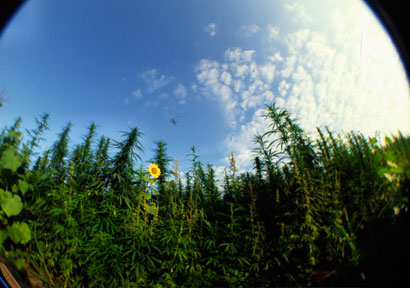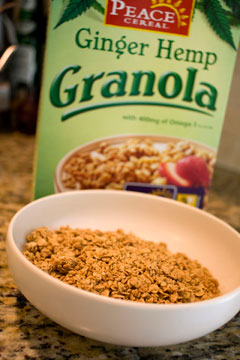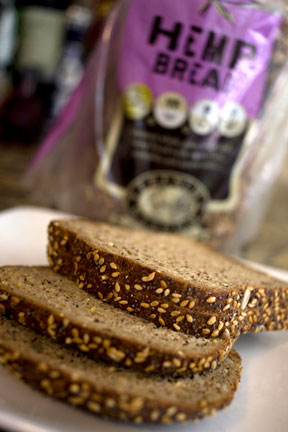Quick: What single plant can you use to build, insulate, and heat a house; help build and run cars; turn into the finest textiles; use to make tortillas, cheese, veggie burgers, perfumes, skin creams, and suntan lotions – and also to get stoned?
 Gotcha. The answer is none. But if you leave out the stoned part, you’re talking about hemp, the non-smokable variety of cannabis sativa, botanical cousin of the cannabis that gets you high. It’s currently grown legally in 30 industrial nations, has a history that dates back to the earliest days of man, was touted by George Washington and Benjamin Franklin, was probably used to make the first American flag, and – if given the chance – might help bring Texas farmers out of troubled times.
Gotcha. The answer is none. But if you leave out the stoned part, you’re talking about hemp, the non-smokable variety of cannabis sativa, botanical cousin of the cannabis that gets you high. It’s currently grown legally in 30 industrial nations, has a history that dates back to the earliest days of man, was touted by George Washington and Benjamin Franklin, was probably used to make the first American flag, and – if given the chance – might help bring Texas farmers out of troubled times.
Unfortunately, industrial hemp’s association with pot has made it illegal to produce here in the United States for the last seven decades, forcing U.S. manufacturers to import it from China, Eastern Europe, and Canada. For a while during the 1990s it was illegal to import it any form but finished textiles. And even that was suspect under Bill Clinton’s drug czar, retired Army Gen. Barry McCaffrey, who, in trying to ban hemp importation, once famously announced to a group of high-ranking Drug Enforcement Administration and U.S. Customs officials that “kids are boiling down their hemp shirts and mixing the essence with alcohol to make marijuana.”
That would be a pretty wacky comment coming from anyone, but to have national policy hinge on such impossible wrong-headedness set back hemp’s future in this country a long way.
Nobody’s using that rhetoric now, but the unease persists in many places, including at the Texas Farm Bureau. Spokesman Gene Hall told Fort Worth Weekly that while “hemp has come up as a possible agricultural crop for Texas, it’s been a controversial subject.” Hall said that neither the Texas Farm Bureau, a nonprofit organization of farmers, ranchers, and rural families, nor the National Farm Bureau have supported industrial hemp as an ag crop “because there are concerns with the farm bureau supporting the raising of a crop that could be used for illicit drug use.”
But times are changing, even in Texas, and not everyone sees it the way Hall and the Farm Bureau do. This week, Oregon became the 16th state to pass some form of industrial hemp legislation, in hopes of making it possible for farmers to grow, own, and sell the nonsmokable but otherwise highly useful forms of hemp, the kinds with very low quantities of THC, the chemical in pot that gets you high.
State laws can’t trump the federal statute, which currently lists cannabis sativa as a controlled substance and prevent its cultivation. But U.S. Rep. Ron Paul, a Libertarian-leaning Republican from Lake Jackson, Texas, is trying to change that. He’s filed a bill to require the federal government to respect state laws on industrial hemp production. Paul has tried and failed at this before, and even he thinks the bill isn’t likely to pass this time either. But he’s gaining some support among his fellow House members and hoping for a friendlier attitude in the White House.
Individually, there are plenty of Texas farmers who are happy to hear about a potential new cash crop.
“If you tell me that there is a crop out there that could earn $400 an acre” – which is what Canadian farmers can earn with hemp – “well, I would have no problem growing it,” said Ralph Snyder, a farmer in North Central Texas. “Farmers would be lined up to grow it.”
Dan Brown, a North Texas leader of the National Organization for the Reform of Marijuana Laws (NORML), figures hemp could thrive easily in Texas. “Remember that it’s one of the fastest, most aggressive- growing biomasses in the world,” he said. “It isn’t called a weed for nothing.”
Hemp wasn’t always a banned crop. In colonial America its cultivation was mandated by British law. Back then it was used to make ropes and sails for ships, in fine art canvas, in paint and varnishes, as lamp oil, to make paper, and in some foods.
But the Marijuana Tax A ct of 1937 that effectively outlawed smoking cannabis also essentially outlawed industrial hemp. The act was passed after publisher William Randolph Hearst’s newspapers waged a protracted and vociferous campaign against “marijuana” – a term he introduced to the American public. He ran stories that suggested that white women who smoked it couldn’t resist the lure of “negroes,” that it would bring out the devil in people and could cause otherwise normal people to become violent to the point of murder. Hollywood jumped on the campaign, releasing films such as Reefer Madness and Marijuana, Assassin of Youth, which showed previously virtuous young women jumping out of windows and becoming prostitutes after their first exposure to the evil weed.
ct of 1937 that effectively outlawed smoking cannabis also essentially outlawed industrial hemp. The act was passed after publisher William Randolph Hearst’s newspapers waged a protracted and vociferous campaign against “marijuana” – a term he introduced to the American public. He ran stories that suggested that white women who smoked it couldn’t resist the lure of “negroes,” that it would bring out the devil in people and could cause otherwise normal people to become violent to the point of murder. Hollywood jumped on the campaign, releasing films such as Reefer Madness and Marijuana, Assassin of Youth, which showed previously virtuous young women jumping out of windows and becoming prostitutes after their first exposure to the evil weed.
Some saw Hearst’s campaign as a disguise for his real purpose – the elimination of industrial hemp, which was just coming into its own as a major modern crop, thanks to new machinery that allowed the hemp to be harvested and cleaned mechanically, rather than by hand. In 1933, Popular Mechanics magazine called industrial hemp “a billion-dollar crop” and suggested that with mechanization it would be used in making more than 25,000 products, including plastics, nylon, and paper.
At about the same time, Hearst had invested in millions of acres of trees for paper pulp, and Dupont, the chemical company, had just received patents for making nylon from coal and plastic from oil. Competition from hemp products might have cost both Hearst and Dupont genuine fortunes. According to Industrial Hemp Now, an organization working to legalize hemp, “As a model of deception and orchestrated media manipulation, the anti-hemp crusade constitutes one of the greatest hoaxes ever perpetuated on the American people. Few public relations campaigns in history can match its success in eradicating competition while transforming citizens into unknowing pawns of big business.” Those claims have been echoed by dozens of others.
World War II changed the federal attitude temporarily. Cut off from vital natural-fiber supplies by the war, the federal government was forced to ask farmers to grow hemp to aid the war effort, even producing the film Hemp For Victory. Afterward, it was back to hemp-is-banned business as usual – except for the millions of leftover wild hemp plants that still grow along roads and highways throughout the Midwest and are the focus of the Drug Enforcement Administration’s “marijuana” eradication efforts, despite the fact that none of the plants have the ability to get anyone high.
In 1970, the newly created DEA developed the Controlled Substances Schedule, which placed drugs in categories according to their medical value and propensity for being abused. Morphine and cocaine, for instance, are in Schedule 2 because they have medical value but are highly likely to be abused. Cannabis, including industrial hemp, was placed in Schedule 1, meaning it has no recognized medical value and is highly likely to be abused. It can’t, under any circumstances, be prescribed by doctors.
The DEA later made an exception for industrial hemp, but those wishing to grow it must have a DEA license. In the past 20 years they’ve given out only a small handful of permits, and the restrictions – including round-the-clock guards on trial plots, exorbitantly expensive fencing, and regular inspections at the licensee’s expense – make it impossible to actually grow anything profitably. Most farmers who have applied for a permit never even receive a response.
 Some industrial hemp promoters see a glimmer of hope with the Obama administration in place. “Little birdies have told me that Obama is going to treat hemp as a state’s right, just as his administration is doing with medical marijuana,” said a hemp product manufacturer who asked not to be named. “And if that’s the case, then it’s ‘all systems go’ in a number of states.”
Some industrial hemp promoters see a glimmer of hope with the Obama administration in place. “Little birdies have told me that Obama is going to treat hemp as a state’s right, just as his administration is doing with medical marijuana,” said a hemp product manufacturer who asked not to be named. “And if that’s the case, then it’s ‘all systems go’ in a number of states.”
The Obama administration has made enforcement of laws against the medical uses of marijuana the lowest priority for the Department of Justice in states that have passed legislation allowing such use. Farmers in states with laws permitting industrial hemp production are hoping he’ll do at least that much for them. Still, until federal law is changed, farmers are going to be wary about turning over land to a crop that might get pulled out from under them.
Ron Paul, the Houston-area congressman, introduced the Industrial Hemp Farming Act in April, which would require the federal government to respect state laws with regards to hemp production. The bill has 11 co-sponsors.
In introducing the proposal, he noted, “Federal law concedes the safety of industrial hemp by allowing it to be legally imported for use as food.” He also said that the United States is the “only industrialized nation that prohibits industrial hemp cultivation.” Stores in this country already sell hemp seeds, oil, and food products, he pointed out, as well as paper, cloth, cosmetics, and carpet containing hemp. It has been used as an alternative fuel for cars, he said, and, most recently, in the door frames of about 1.5 million cars.
Paul said Tuesday that he holds out little hope for his bill. “If we could bring it to the floor and discuss it and teach people what it is, well, I think it would be passed overwhelmingly,” he said. “But right now, unfortunately, you still have a lot of people who think it’s a drug. And as long as they’re that uninformed, they’re not going to see the real issue.”
Creating a viable hemp industry in this country would take more than legislation, of course. Public awareness of, and demand for, hemp products would have to grow considerably before enough quantities would be needed to make it a profitable crop for large numbers of farmers.
When his country began allowing the production of industrial hemp 10 years ago, said Canadian crop specialist Harry Brook, farmers initially misjudged the market and overproduced. “Our farmers began growing hemp for fiber, and unfortunately, we didn’t have the facilities in place to convert that to paper and textiles and such, and so essentially it was a bust.”
But the farmers switched to growing it for seed, used to make oil and food products. “Now that’s where they found a market,” Brook said. “And now there’s talk about reviving the fiber industry because [hemp] grows so fast and tall and produces so much fiber. But that simply won’t get off the ground until someone decides to make the investment in the factories that can utilize it.”
In ideal conditions, he said, hemp can produce about 5 tons of dried biomass per acre in 100 days – considerably more than any other crop. And with its varied uses, its potential is unlimited.
Gordon Scheifele is a retired certified plant breeder with the Canadian Ministry of Agriculture who is currently researching hemp. The stumbling block right now, he said, is that there isn’t a single commercial processor in North America that can produce the fibers in sufficient quantities to sustain various industries.
 “We know we can produce it in Canada. We already are [doing so],” he said. “But the next step requires vision, will, determination, and effort. That includes the capital to make it all go.”
“We know we can produce it in Canada. We already are [doing so],” he said. “But the next step requires vision, will, determination, and effort. That includes the capital to make it all go.”
In this country, groups such as Hemp Industries Association and VoteHemp.org estimate the current annual sales of hemp products in 2008 totalled about $360 million. Designers such as Donatella Versace, Ralph Lauren, Donna Karan, and Calvin Klein have produced everything from hemp-and-cotton-blend jersey knits to hemp-and-silk-blend clothing. Wal-Mart carries a line of hemp suntan lotion and skin creams; Whole Foods and Central Market carry several products from hemp bread and granola to frozen desserts. The Body Shop carries a line of skin-care products.
In San Marcos, Hemp Town Rock – The Hemp Store, has been operating since 1992. And near McKinney, DiaperCo.com sells a line of hemp diapers. But it’s all still just a drop in the bucket compared to what would happen if the crop were legalized.
“What’s being sold now and what can be sold when American farmers are given the green light to produce hemp are worlds apart,” said Oregon State Sen. Floyd Prozanski, who introduced that state’s industrial hemp bill. “We’ve got a hemp food company in Portland, Living Harvest, that currently has $20 million in annual revenues, but they project that in five years they will have revenues of over $100 million annually. That’s exponential growth. And imagine what it could be if they could get their raw products closer to their production sites instead of having to import their seed and oil from Canada? If you bring your prices down, and you’ve got a good product, well, sales climb.
“We’re at a stage now where a lot of the American public recognizes that we were hoodwinked by the DEA and others into demonizing industrial hemp,” he said.
Lawrence Serbin, former national director for the Business Alliance for Commerce in Hemp and owner of Hemp Traders, a Los Angeles-based company, said this country is “really in a Catch-22” regarding hemp. “The reality is that hemp won’t become more popular in the U.S. until the price goes down, and the price won’t go down until it gets more popular. And the only way to make that price go down is to have us produce our own hemp.”
Serbin’s company sells a range of hemp products, from textiles to paper, but what he’s really concentrating on is fiberboard, which he makes from the hurds, the inner woody part of the hemp stalk left after the fiber has been removed. Typically, hurds are burned or left on the ground as mulch after harvest. He has to go to China to get them.
Beginning in 1999, he said, “We came in and collected the hurds and brought them to a factory and had them make up some medium-density fiberboards with it.” It’s taken him several years to come up with the product he’s just put on the market, a hemp fiberboard bound with a product derived from eucalyptus bark.
The advantage to his fiberboard, he said, is that it’s made without wood pulp and doesn’t use formaldehyde, a standard, inexpensive binder that is carcinogenic. The disadvantage is the price: His half-inch-thick, 4′-by-8′ boards go for about $28, nearly double what similar wood composite and particle boards go for in places like the Home Depot. His primary cost, he said, is transportation. The factory in China where part of the manufacturing takes place is far away from where the hemp is grown. And both hurds and boards are bulky, increasing the transit costs.
 He hopes to solve part of the problem by building a factory next to the hemp fields in China, which he said could make his fiberboards “instantly competitive with regular wood boards.” If he could get the hurds from U.S. farmers, he said, he could sell his boards far more cheaply than what’s currently on the market.
He hopes to solve part of the problem by building a factory next to the hemp fields in China, which he said could make his fiberboards “instantly competitive with regular wood boards.” If he could get the hurds from U.S. farmers, he said, he could sell his boards far more cheaply than what’s currently on the market.
Hemp boards, he said, could have “a huge impact on the housing market here in the U.S. … The effect on our forests would be immediate; new home prices would drop, and your house wouldn’t be full of formaldehyde.” He too is hoping that the Obama administration will tell federal law enforcement agencies to “leave it [hemp enforcement] to the states and then leave the states alone.”
Dave Seber, owner of Oregon’s Fibre Alternatives, believes industrial hemp is a “critical component” in saving both the economy and the environment in the United States.
“How are we going to stop carbon accumulation if we keep taking the trees down?” he asked. “We can’t, unless we grow hemp.” Hemp products, he said, could reduce the cost of building materials by 30 to 50 percent. “And that’s what we need to get the building industry, and therefore the economy, back on its feet.” He believes hemp could be used for furniture-quality boards. And he’s seen it used in Europe as a base for concrete, as a replacement for fiberglass insulation, and for plastics for everything from countertops to car parts.
Many countries in the European Union have begun levying fines on automakers and car sellers if their vehicles are not made of recyclable materials. That led European car manufacturers to begin replacing traditional plastic parts with parts made from hemp, flax, and other natural fibers. In 2007 Lotus introduced its Hemp Eco Elise, a high-end car with a body largely made from hemp fiberglass and seats and other interior parts made largely from hemp/wool/flax materials.
“You’ve got to look at the big picture,” Seber said. “The food and textile industries, as well as paper and such, can definitely benefit from hemp products … but I think you have to look at the major industries if you really want to make the environmental and economic changes that this country and the whole world desperately need. Those are the housing industry, the biofuel industries, the plastics industries, and the automobile industries.”
Thus far, however, that potential revolution is passing Texas by.
Calls to a dozen legislators and agricultural committee members around Texas produced very little feedback and even less knowledge about hemp-based industries. A spokesman for State Rep. Charles Anderson of Waco, vice-chair of the Texas House Agriculture and Livestock Committee, said he’d never heard the issue discussed. The Texas Agricultural Policy Council didn’t respond to e-mail queries. Brian Black, assistant to the commissioner for the Texas Department of Agriculture, said, “I’ve not heard of any discussion of industrial hemp in the agriculture industry in Texas.” Calls to the office of U.S. Sen. John Cornyn, the Texas Republican who sits on the Senate Committee on Agriculture, Nutrition and Forestry – three areas that would be affected by hemp production – were not returned.
Even a member of the Texas Organic Farmers and Gardeners Association, who asked not to be named, laughed at the notion of hemp being grown in Texas. “We can’t even get Texas interested in organic food research, so I doubt very much you’re going to find many politicians in Texas willing to discuss hemp research. That’s just not how people think here.”
“We in Texas wo uld go along with hemp if there were a change in the national policy,” said Hall, of the Texas Farm Bureau. “There are very legitimate uses for hemp in industry. But because of the controversy with illegal drug use, we simply don’t have a position on hemp at this time.”
uld go along with hemp if there were a change in the national policy,” said Hall, of the Texas Farm Bureau. “There are very legitimate uses for hemp in industry. But because of the controversy with illegal drug use, we simply don’t have a position on hemp at this time.”
Right now, there seems to be only one real hemp store left in Texas, out of the healthy crop that flourished here in hippier-dippier times. Rose Phillips’ Hemp Town Rock is still going strong. When she opened the store in 1992, Phillips said, she sold only products made from hemp – clothing, food, paper, twines, and such.
“Unfortunately,” she said, “I’ve had to add other products over the years because hemp is just plain expensive, what with all of it having to be imported. Now if we could grow it here, that would be different. You bring the price down, and everybody would buy hemp because it’s such a nice material and so durable. But as it is, well, with the economy down, except for Christmastime I don’t put out a lot of my better hemp clothes.”
She still carries hemp purses, wallets, t-shirts, and other products but admits they aren’t enough by themselves to keep her in business.
“There’s a big market” for hemp products,” she said. “But most people would rather just order it from a web page that can sell it cheaper than I can, what with store overhead. And then every major chain store carries some hemp products, so a store like mine isn’t the only place to get those things anymore.”
One of the local online stores that sells a lot of hemp products is DiaperCo.com. Based in Anna, just north of McKinney, the cloth diaper company has nearly 50 hemp-blend products for sale. Jessica Land, a DiaperCo manager, said the products sell well. “A lot of what we sell are hemp inserts – hemp cloth that goes inside pouches in the diaper. And everybody loves them because the hemp is so absorbent.”
Her client base is interested in environmentally friendly, natural products that are reusable, she said. “And what fits that description better than hemp?”
Has she ever had any clients decide not to buy hemp because of its connection with marijuana? She laughed. “I’ve never heard anyone say that, but our client base is pretty well informed,” she said. “I imagine there would be some people who would think that, though.”
 Even if federal law were changed to allow unimpeded hemp production, Scheifele said he’s not sure whether Texas would be a prime growing area.
Even if federal law were changed to allow unimpeded hemp production, Scheifele said he’s not sure whether Texas would be a prime growing area.
“Hemp requires moisture. The rule of thumb is that wherever you can grow corn you can grow good hemp,” he said. (Texas now ranks 12th among U.S. states in corn production.) Hemp is drought resistant, though, and winter crops probably would work here, Scheifele said. Beyond that, if it became a legal crop, he said, researchers would develop strains adaptable to a wide variety of conditions. In Australia, he said, scientists report they have developed a more drought-tolerant variety.
Don Wirtshafter, a lawyer and pioneer in the hemp movement who spent years researching hemp varieties in southeast Asia, said he thinks he’s already got seed stock that would work well in much of Texas without irrigation. His stock, brought over from Asia some years ago, is being kept alive in Canada, waiting a change in hemp’s legal status in this country, before he can try test plots all over the state.
He pointed out that in China, hemp is relegated to poorer-quality farmland. “If you’re growing for seed, you definitely need good nutrition, good soil,” he said. “But if you’re growing for fiber you can grow it almost anywhere.”
Wirtshafter called it an “agricultural tragedy” that thousands of varieties of hemp seed were lost when laws outlawing hemp cultivation were passed in this country and copied by much of the world.
Brown, the assistant director of the Dallas/Fort Worth chapter of NORML, said that growing industrial hemp in Texas is a no-brainer. “Look at East Texas. There’s plenty of moisture there. It’s ideally suited for hemp cultivation. But with some irrigation you could grow hemp anywhere in the state.”
He pointed to the arid landscape of northern Mexico, home to tens of thousands of acres of low-grade marijuana. “If you can grow marijuana in those near-desert conditions, you could certainly grow hemp in southern Texas,” he said. “And with the ethanol craze going on and our focus on growing our own fuel stocks, it would be entirely possible to grow industrial hemp in quantities to replace American dependence on foreign oil. Hemp produces more than twice the biomass per acre that corn does, so it would be a natural for fuel, and we could grow a lot of it on land not currently utilized for agriculture, rather than using good soil to grow corn for ethanol.”
In fact, he said, traditionally independent Texas farmers could come to see hemp-growing as a right they’re being denied. “Texans don’t like their personal rights abridged,” he said. “And once they understand the difference between marijuana and industrial hemp, your average Texas farmer would probably demand the right to grow it.
Daniel Leshiker, who farms near Ralph Snyder in North Central Texas, agreed with Snyder that hemp sounds intriguing.
“We already need another crop, that’s for certain. I just planted 200 acres of sunflowers for their seed for the first time,” he said. “So while I don’t know much about hemp except they used to make rope with it, well, you tell me I could make money with it, and I’ll grow it. That’s what we are in the business to do.”











